Date: 8 June, 2001
Port of Call: Hampton, Virginia
Subject: The Ditch
The last several weeks have been more like a yacht delivery than a cruise as we rushed our way up the Intracoastal Waterway. On May 24 we left the beautiful splendor of the Waccamaw River behind, and watched as the waterway changed abruptly from the chain of interconnected rivers and sounds of Georgia and southern South Carolina's Low Country to a man-made canal. Most boaters call the Intracoastal Waterway "The Ditch", and this part fits the bill. As we proceed up the canal a few miles inland from Myrtle Beach, South Carolina, we are amazed at the changes that have occurred since our last trip this way. What had once been a quiet tree-lined canal has now sprouted miles of condominiums and expensive homes. Manicured green lawns lead to docks sporting personal watercraft and small runabouts. A half-dozen new bridges span the waterway, including one that has been built since our 2001 Waterway Guide was published. We are saddened by all this development and the loss of a little more of nature's beauty.
We intended to spend our first night in The Ditch at Barefoot Landing, a free dock located at a shopping mall that fronts the waterway. We are looking forward to dinner at one of the restaurants there. When we arrive, we find dockside depths barely enough for our six-foot draft. The wake from each passing boat lifts Sovereign up and then drops her onto the bottom of the canal. The whole boat shudders and the rigging shakes with each wave. We decide to forego the restaurant and continue on, and we anchor for the night in Calabash Creek, right on the South Carolina/North Carolina boarder.
Pontoon bridge across the waterway
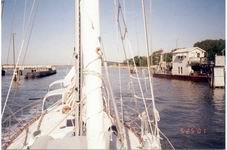 The next day we motor up The Ditch in light winds, and pass through the only
pontoon bridge on the waterway. This is an unusual bridge which, rather
than lifting or swinging out of the way of boat traffic, actually floats!
It is pulled out of the channel by steel cables, which the bridge tender
then loosens until they are slack enough so that we can pass over them.
The ICW canal cut eventually runs into the Cape Fear River, and we motor
upstream, bucking a 2 1/2 knot current. We anchor for the night in
Carolina Beach, whose harbor is surrounded on all sides by houses and condominiums.
The next day we motor up The Ditch in light winds, and pass through the only
pontoon bridge on the waterway. This is an unusual bridge which, rather
than lifting or swinging out of the way of boat traffic, actually floats!
It is pulled out of the channel by steel cables, which the bridge tender
then loosens until they are slack enough so that we can pass over them.
The ICW canal cut eventually runs into the Cape Fear River, and we motor
upstream, bucking a 2 1/2 knot current. We anchor for the night in
Carolina Beach, whose harbor is surrounded on all sides by houses and condominiums.The following day we have a southerly breeze of 10 to 15 knots, and we unroll the Yankee and motorsail up the waterway, catching all the bridge openings just right. All that afternoon the VHF radio's NOAA Weather Alert alarm keeps going off, telling us about approaching bad weather. We rush to anchor for the night at Mile Hammock Bay, at the corner of Camp Lejune. Shortly after we anchor, a nasty line of squalls goes through the anchorage. As we peer out the ports to watch the weather, we remember a similar storm the last time we were here: The lightning was so close we could smell the ozone produced as the bolts of electricity ionized the air. Fortunately, this storm is not nearly as bad, and it eventually gives way to a relatively quiet night at anchor.
The next day is Sunday and it is also Memorial Day Weekend. As we motorsail up the waterway past Swansboro and Morehead City, we are subjected to the wakes of literally hundreds of holiday boaters as they zip past us. That afternoon we enter the anchorage in Beaufort (BOH-fert) North Carolina and have to go further up the river than we ever have to find a clear spot to drop the anchor.
Stormy skies over Beaufort, NC
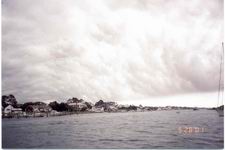 After being under way for 12 of the last 13 days, we decide to stop a few
days in Beaufort. On Monday morning we visit the North Carolina Maritime
Museum, and enjoy a new exhibit about the excavation of a ship believed to
be Blackbeard's flagship. That afternoon the weather alarm goes off
again with another severe storm warning. The boat anchored just east
of us decides the channel is too narrow for the approaching bad weather and
pulls out just as the storm hits. We are anchored in a slightly wider
spot, and decide to sit it out while standing an anchor watch. Our stern
swings very close--less than a boat length--from some nearby rocks, but the
depth sounder reads 18 feet, so we wait it out. The clouds are low and dark
and are unlike anything we have ever seen--they have unusual striations,
like fudge-ripple ice cream, except in shades of gray. A strong gust
of wind comes through, and an unattended boat drags through the anchorage
and comes to rest just off our port bow, even closer to shore than we are.
Fortunately the storm lightens up quickly and our only worry is that our
new neighbor will swing into us when the tide changes. We eventually
decide to set a second anchor to keep ourselves away from this new hazard.
This is the first time in years we have found it necessary to have out two
anchors, but it is a better option than trying to fit into the tight pack
of boats closer to the city, or trying to re-anchor the other boat whose
anchors dragged. Finally, several hours later the owners of the boat
come back, haul up their tiny anchors, and are gone without a word.
We spend a fairly restless night worried about the very active weather, but
have no more mishaps.
After being under way for 12 of the last 13 days, we decide to stop a few
days in Beaufort. On Monday morning we visit the North Carolina Maritime
Museum, and enjoy a new exhibit about the excavation of a ship believed to
be Blackbeard's flagship. That afternoon the weather alarm goes off
again with another severe storm warning. The boat anchored just east
of us decides the channel is too narrow for the approaching bad weather and
pulls out just as the storm hits. We are anchored in a slightly wider
spot, and decide to sit it out while standing an anchor watch. Our stern
swings very close--less than a boat length--from some nearby rocks, but the
depth sounder reads 18 feet, so we wait it out. The clouds are low and dark
and are unlike anything we have ever seen--they have unusual striations,
like fudge-ripple ice cream, except in shades of gray. A strong gust
of wind comes through, and an unattended boat drags through the anchorage
and comes to rest just off our port bow, even closer to shore than we are.
Fortunately the storm lightens up quickly and our only worry is that our
new neighbor will swing into us when the tide changes. We eventually
decide to set a second anchor to keep ourselves away from this new hazard.
This is the first time in years we have found it necessary to have out two
anchors, but it is a better option than trying to fit into the tight pack
of boats closer to the city, or trying to re-anchor the other boat whose
anchors dragged. Finally, several hours later the owners of the boat
come back, haul up their tiny anchors, and are gone without a word.
We spend a fairly restless night worried about the very active weather, but
have no more mishaps.The next day we go ashore early to the Maritime Museum to pick up the courtesy car we have reserved. We are allowed to use the car for two hours, so we must fit all of our errands in this short time. The first stop is the alternator shop, where we drop off our damaged high-output alternator for repairs. The repairman thinks it will take about 30 minutes to fix, and he can do it right away, so we leave the alternator and head off for a marine chandler and grocery store. We rush through those errands and arrive back at the alternator shop about an hour after we left. The repairman yells from the back room that he's working on our alternator now, and that he will be done soon. Tinkering noises filter out to us from in back. Time is ticking away. We mentally cross off a visit to the hardware store from our list. More noises; I glance nervously at my watch. We mentally cross off driving to the Yanmar dealer to pick up some oil filters. A very long silence ensues. It is already past time that we should head back to return the car. The repairman yells from the back that he's almost done. We decide to call the Maritime Museum and find out if someone else has reserved the car after us. Fortunately no one has, and we can keep it a little longer if we need to. After nearly an hour the repairman appears from the back of the shop with our alternator. It's all fixed and costs only $35. We thank him very much for taking care of it while we waited, and head off to gas up and then unload all our new goodies before returning the car. Did I mention it's raining? It's raining. We unload the groceries to the shelter of a small gazebo by the dinghy dock. Cathy waits with the groceries while I return the car and walk back in the rain. We carry the groceries to the dinghy and motor out to Sovereign, trying to keep the bread, the alternator, and a few other goodies dry.
Cathy in Beaufort, NC
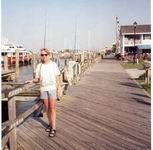 That afternoon there is a little break in the rain, and we decide to do laundry.
We carry the laundry to the laundromat and start the wash. I decided
to take the dinghy around to the Yanmar dealer and try and get the filters
we couldn't get earlier. As soon as I reach the dinghy it starts to
rain again. Foolish optimists that we are, we didn't bring any rain
gear (again). I get soaked on the trip over, buy the parts, and get
soaked coming back. I drop off the parts at Sovereign, and dinghy back
to pick up Cathy at the laundromat. She looks as dry and clean as our
new laundry. She bags it up protectively in plastic garbage bags (why
do we have stuff to keep the laundry dry, but nothing for ourselves) and
we carry it back to the dinghy. It always seems to rain when we go
grocery shopping or do laundry. Today we did both, so it rained extra
hard. Oh well. A warm shower and dinner made us feel much better.
That afternoon there is a little break in the rain, and we decide to do laundry.
We carry the laundry to the laundromat and start the wash. I decided
to take the dinghy around to the Yanmar dealer and try and get the filters
we couldn't get earlier. As soon as I reach the dinghy it starts to
rain again. Foolish optimists that we are, we didn't bring any rain
gear (again). I get soaked on the trip over, buy the parts, and get
soaked coming back. I drop off the parts at Sovereign, and dinghy back
to pick up Cathy at the laundromat. She looks as dry and clean as our
new laundry. She bags it up protectively in plastic garbage bags (why
do we have stuff to keep the laundry dry, but nothing for ourselves) and
we carry it back to the dinghy. It always seems to rain when we go
grocery shopping or do laundry. Today we did both, so it rained extra
hard. Oh well. A warm shower and dinner made us feel much better.Sailing under spinnaker
 The next day we get a late start, around 1030, and begin motoring up the
waterway again. Finally the canal cut opens onto the Neuse River, and
we are out of The Ditch for a while. The wind is fair, and we raise
the full mainsail, staysail and yankee. We shut down the engine and
enjoy the silence. The wind strength varies quite a bit, and we find
ourselves making only 2 1/2 knots. I decide to raise the spinnaker.
That does the trick, and our boat speed increases to 4 1/2 knots. The
wind starts filling in, and we ease up to 5, then 6, 7, 7.4 knots!
At this point we are nearing the upper limit of the light spinnaker's capabilities,
so we drop the sail. As I tie off the spinnaker halyard, I notice that
the block at the masthead is fouled, and can't be freed from on deck.
This little problem somehow spoils the great mood of the sail for me, and
we motor the two remaining miles into our anchorage for the night.
Once safely anchored, Cathy hoists me up the mast on the main halyard, and
I clear the foul and come back down. Then, just after dinner, the wind
unexpectedly shifts 180 degrees and starts blowing 20 knots from the only
direction this anchorage is exposed to. The weather radio glibly keeps
on predicting the old wind direction, and we have our first uncomfortable
anchorage since the Bahamas.
The next day we get a late start, around 1030, and begin motoring up the
waterway again. Finally the canal cut opens onto the Neuse River, and
we are out of The Ditch for a while. The wind is fair, and we raise
the full mainsail, staysail and yankee. We shut down the engine and
enjoy the silence. The wind strength varies quite a bit, and we find
ourselves making only 2 1/2 knots. I decide to raise the spinnaker.
That does the trick, and our boat speed increases to 4 1/2 knots. The
wind starts filling in, and we ease up to 5, then 6, 7, 7.4 knots!
At this point we are nearing the upper limit of the light spinnaker's capabilities,
so we drop the sail. As I tie off the spinnaker halyard, I notice that
the block at the masthead is fouled, and can't be freed from on deck.
This little problem somehow spoils the great mood of the sail for me, and
we motor the two remaining miles into our anchorage for the night.
Once safely anchored, Cathy hoists me up the mast on the main halyard, and
I clear the foul and come back down. Then, just after dinner, the wind
unexpectedly shifts 180 degrees and starts blowing 20 knots from the only
direction this anchorage is exposed to. The weather radio glibly keeps
on predicting the old wind direction, and we have our first uncomfortable
anchorage since the Bahamas.The next day takes us across the rest of the Neuse River, through another canal cut, and across Pamlico Sound. Once again we enjoy being in open waters, and we sail, albeit slowly, across the sound to our next night's anchorage. Another day of motoring and motorsailing brings us through the Alligator-Pungo Canal to the head of the Alligator River. We anchor under gray skies and strong breezes and hunker down for another night of unsettled weather. Eight years ago at this same anchorage we experienced the most spectacular lightning display we have ever seen, and it looks like we are in for a repeat performance tonight. For most of the night the lightning flashes, the wind blows, and thunder rumbles in the distance. I get up frequently to check the GPS for any indication that our anchor is dragging (it's not), and to make sure everything is OK.
Nice sailing across Albemarle Sound
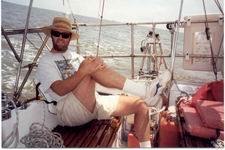 The rough night is followed by a long but pleasant day: we had 50 miles
to go to get to Elizabeth City, and nowhere to stop along the way.
We are under way by 0645, motorsailing with the yankee for the first 25 miles
or so, until we have passed through the Alligator River Swing Bridge and
around a shoal that looks difficult on the chart. Then we raise a single-reefed
main (the forecast is for building southwesterlies), stays'l and yankee,
and set out on a broad reach across the Sound. The complete overcast
of early morning gives way to a sparkling clear day. We make between
four and five knots, a little too slow to arrive at Elizabeth City at a reasonable
hour, so we shake out the reef and the boatspeed steadies at around five.
Entering the Pasquotank River necessitates a 90-degree turn to port, so we
are hard on the wind. As we head into the wind, the apparent wind increases,
and we find we need the reef after all. We sail up the river close-hauled,
dodging the crab buoys and enjoying the feel of a boat heeling to the gusts
in flat water. Eventually the wind increases, and we put in a second
reef in the main. The river dodges to the right a little, and we crack
off onto a close reach, barreling along at a steady six knots, making as
much as 7.4 in the puffs. We pass through a fleet of racing boats,
dipping the sterns of the close-hauled boats and dodging the ones running
down from the upwind mark. As we run out of river, we roll up the jibs
and drop the main. We arrive at Elizabeth City a little after 1500
and make a near-perfect show of ourselves tying to the pilings off the city
waterfront. It is one of those few great days of sailing that one rarely
gets when travelling the Intracoastal Waterway.
The rough night is followed by a long but pleasant day: we had 50 miles
to go to get to Elizabeth City, and nowhere to stop along the way.
We are under way by 0645, motorsailing with the yankee for the first 25 miles
or so, until we have passed through the Alligator River Swing Bridge and
around a shoal that looks difficult on the chart. Then we raise a single-reefed
main (the forecast is for building southwesterlies), stays'l and yankee,
and set out on a broad reach across the Sound. The complete overcast
of early morning gives way to a sparkling clear day. We make between
four and five knots, a little too slow to arrive at Elizabeth City at a reasonable
hour, so we shake out the reef and the boatspeed steadies at around five.
Entering the Pasquotank River necessitates a 90-degree turn to port, so we
are hard on the wind. As we head into the wind, the apparent wind increases,
and we find we need the reef after all. We sail up the river close-hauled,
dodging the crab buoys and enjoying the feel of a boat heeling to the gusts
in flat water. Eventually the wind increases, and we put in a second
reef in the main. The river dodges to the right a little, and we crack
off onto a close reach, barreling along at a steady six knots, making as
much as 7.4 in the puffs. We pass through a fleet of racing boats,
dipping the sterns of the close-hauled boats and dodging the ones running
down from the upwind mark. As we run out of river, we roll up the jibs
and drop the main. We arrive at Elizabeth City a little after 1500
and make a near-perfect show of ourselves tying to the pilings off the city
waterfront. It is one of those few great days of sailing that one rarely
gets when travelling the Intracoastal Waterway.Park in Elizabeth City
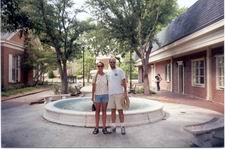 We spend three nights tied to Mariner's Wharf in downtown Elizabeth City.
We love their hospitality: boaters are treated to 48 hours free dockage
and nightly wine and cheese parties hosted by Fred Fearing, the leader of
the famed Rose Buddies. We stroll the streets of this charming southern
city, and mingle with other boaters who we had seen along the Waterway, but
hadn't yet met. It is our sixth visit here, so it's starting to feel
a bit like home. We also take care of all the errands and shopping
we hadn't been able to do elsewhere.
We spend three nights tied to Mariner's Wharf in downtown Elizabeth City.
We love their hospitality: boaters are treated to 48 hours free dockage
and nightly wine and cheese parties hosted by Fred Fearing, the leader of
the famed Rose Buddies. We stroll the streets of this charming southern
city, and mingle with other boaters who we had seen along the Waterway, but
hadn't yet met. It is our sixth visit here, so it's starting to feel
a bit like home. We also take care of all the errands and shopping
we hadn't been able to do elsewhere.Finally, on June 5th, we slip our docklines for our trip up the Dismal Swamp. The Swamp remains unchanged from our previous visits. It is still one of the nicest places on the entire Intracoastal Waterway. Trees still line both sides of the waterway. The water is fresh, but is tea-dark and without a ripple. Once into the Dismal Swamp Canal it is almost too narrow to turn the boat around. We lock up at South Mills and motor on to the North Carolina Welcome Center. This is the only welcome center for both boaters and motorists in the United States, and it has its own personality. The dock is already crowded with six other boats when we arrive, and we raft up next to a German couple for the evening.
Boats rafted at North Carolina Welcome Center
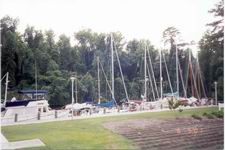 As if to give us a final goodbye, North Carolina's turbulent atmosphere takes
one more swipe at us. We awaken in the middle of the night to one more
rain and lightning storm. Fortunately in the tree-lined banks of the
canal, securely tied to a dock, there is little to worry about, and we easily
fall back to sleep.
As if to give us a final goodbye, North Carolina's turbulent atmosphere takes
one more swipe at us. We awaken in the middle of the night to one more
rain and lightning storm. Fortunately in the tree-lined banks of the
canal, securely tied to a dock, there is little to worry about, and we easily
fall back to sleep.Motoring through the Dismal Swamp
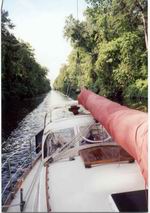 The next morning we motor on to the Deep Creek locks, and we lock back down
into salt water once again. Within a few minutes we are thrust from
the woods of the Dismal Swamp into the bustle of a huge shipping port. We
cross under bridges clogged with city traffic. We pass docked submarines,
destroyers, aircraft carriers, and mothballed Liberty ships. We are
passed in turn by ferries, towboats, and tour boats. Motoring through
Hampton Roads and past the busy Norfolk shipyards is the nautical equivalent
of driving on a crowded Interstate highway. Someone is always passing
or about to be passed, and it requires constant attention. We know
for sure that we aren't on the Intracoastal Waterway any more.
The next morning we motor on to the Deep Creek locks, and we lock back down
into salt water once again. Within a few minutes we are thrust from
the woods of the Dismal Swamp into the bustle of a huge shipping port. We
cross under bridges clogged with city traffic. We pass docked submarines,
destroyers, aircraft carriers, and mothballed Liberty ships. We are
passed in turn by ferries, towboats, and tour boats. Motoring through
Hampton Roads and past the busy Norfolk shipyards is the nautical equivalent
of driving on a crowded Interstate highway. Someone is always passing
or about to be passed, and it requires constant attention. We know
for sure that we aren't on the Intracoastal Waterway any more.Carousel in Hampton, Virginia
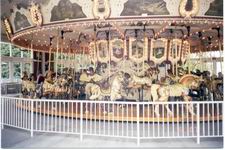 We are now anchored in the tight little harbor of Hampton, Virginia.
We will spend a few days here going to the marine store, getting a few last
perishable goods, and waiting for weather to head for New England.
We are a little sad to leave behind the Intracoastal Waterway with its well-protected
anchorages and easy navigation. But we are looking forward to our trip
north: getting back onto open water, where maybe we can sail more than
we motor; where we can take our time instead of rushing; where we hope things
will be a little less crowded and a little less civilized than the waterfront
lawns that make up much of The Ditch.
We are now anchored in the tight little harbor of Hampton, Virginia.
We will spend a few days here going to the marine store, getting a few last
perishable goods, and waiting for weather to head for New England.
We are a little sad to leave behind the Intracoastal Waterway with its well-protected
anchorages and easy navigation. But we are looking forward to our trip
north: getting back onto open water, where maybe we can sail more than
we motor; where we can take our time instead of rushing; where we hope things
will be a little less crowded and a little less civilized than the waterfront
lawns that make up much of The Ditch.Smooth sailing,
Jim and Cathy